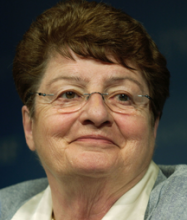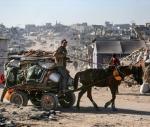You are here
Puerto Rico's bad-governance limbo
Oct 26,2022 - Last updated at Oct 26,2022
WASHINGTON, DC — Puerto Rico is part of the United States, but it is not a state. It is a territory (and a commonwealth) with its own constitution, approved by the US Congress. The island is subject to federal law, the US dollar is its currency, and Puerto Ricans are US citizens, though they cannot vote in federal elections and do not have a voting representative in Congress. There are also differences between the mainland and the island when it comes to federal benefit entitlements, income-tax treatment, business regulations, and other measures.
Puerto Rico’s links with the mainland are important. US citizenship enables free movement of people to and from the mainland, and the dollar and US law clearly have value. In 2020, Puerto Rico’s per capita income was $31,430, well below the US average of $69,300 but far above most Latin American countries.
Puerto Rico’s economy has, however, done poorly over the past two decades, and its per capita income is estimated to have fallen by about 12 per cent in real (inflation-adjusted) terms between 2004 and 2020. Its population has shrunk as many have migrated to the mainland. The commonwealth was already bankrupt in 2015, before Hurricanes Maria (2017) and Fiona (2022) devastated the island. These natural disasters compounded the effects of gross economic mismanagement, which largely reflects the interaction between US federal policies and Puerto Rico’s own policies.
For example, Puerto Rican labor policies have long granted employees more rights relative to their counterparts on the mainland. While the island is subject to the federal minimum wage, which is already too high for it, given its low per capita income, its own laws set the minimum wage even higher. Employers have also faced penalties for layoffs after three months of employment (which discourages apprenticeship and training programmes); and provisions for sick leave, holidays, and vacation are all more generous than those on the mainland.
These measures resulted in a formal labour force participation rate of only about 40 per cent in 2015 (compared with 62 per cent for the US as a whole). Consequently, there was a very large informal sector, and full-time employment at the minimum wage was about 77 per cent of per capita income, compared with 28 per cent on the mainland in the middle of the last decade. These conditions almost certainly contributed to the high rate of out-migration. Owing to its pervasive, ill-advised economic policies, Puerto Rico ranked 65th (out of 190) in in the World Bank’s 2020 Ease of Doing Business index, below Mexico and Ukraine, and down from 47th in 2015.
Like its labour laws, Puerto Rico’s sad history of electricity provision is also quite revealing. Parts of the island were left without power for months after Hurricane Maria, and despite billions of dollars being spent to restore the grid after that episode, much of the island found itself without power again after Fiona. Long before Maria, the island’s electricity supply was erratic and unreliable. Because it was managed by a government-owned and operated electric company, PREPA, public entities were not charged for their electricity use, and charges were also kept low for commercial and residential users.
Since this approach obviously was not sustainable, PREPA neglected maintenance and borrowed billions of dollars from foreign creditors simply to continue functioning. Generator failures, blackouts (at a rate four times higher than on the mainland), worker injuries and deaths, and environmental violations occurred frequently. A report by Synapse Energy Economics, a Massachusetts-based environmental consultancy, noted that power lines were “cracking, corroding, and collapsing”. But costs were also higher than necessary, not least because the US Jones Act (which bars foreign-registered ships from transporting goods between US ports) had increased the price of oil, the chief input for the island’s electric power.
The US Federal Emergency Management Agency is empowered to finance the reconstruction of power lines and to provide some funding for improving resiliency, but not to overhaul the entire system. So, Puerto Rico’s electricity system was restored to its previous vulnerable state after Maria.
Given that the island is frequently hit by hurricanes, greater decentralisation of its power generation through a series of microgrids would reduce its vulnerability. But PREPA’s generators are concentrated in the southeast, and power is then transmitted by above-ground cables over the island’s mountain range. Without upgrades, the damage from the next big hurricane will be just as extensive as the last one, and just as costly for both Puerto Rico and FEMA. Though the cost of upgrading would exceed the cost of replacement this time, it would be far less than the cost of repeatedly replacing (and misplacing) the outmoded and vulnerable grid. By law, however, FEMA cannot pay for such an upgrade.
Puerto Rico has held six plebiscites on its status since 1967, with its residents voting on options ranging from maintaining the status quo to pursuing independence. That the issue remains unsettled has damaged federal and commonwealth decision-making. Some “privileges”, such as tax-exempt treatment for US companies that establish production facilities in Puerto Rico, have been a mixed blessing. While this exemption encouraged the pharmaceutical industry to use Puerto Rico’s capital and skilled labour (though not many unskilled workers), there was always uncertainty about its duration; in fact, it was rescinded and phased out in 2006.
Similarly, Puerto Rico has missed out on some of the benefits of statehood. Were it to become a US state, it would receive an estimated $12 billion more per year from the federal government.
Puerto Rico’s experience offers many lessons. But among the most important is that it is crucial to build and maintain institutions that can carry out appropriate economic-policy decisions across layers of government.
Anne O. Krueger, a former World Bank chief economist and former first deputy managing director of the International Monetary Fund, is senior research professor of International Economics at the Johns Hopkins University School of Advanced International Studies and senior fellow at the Centre for International Development at Stanford University. Copyright: Project Syndicate, 2022.











